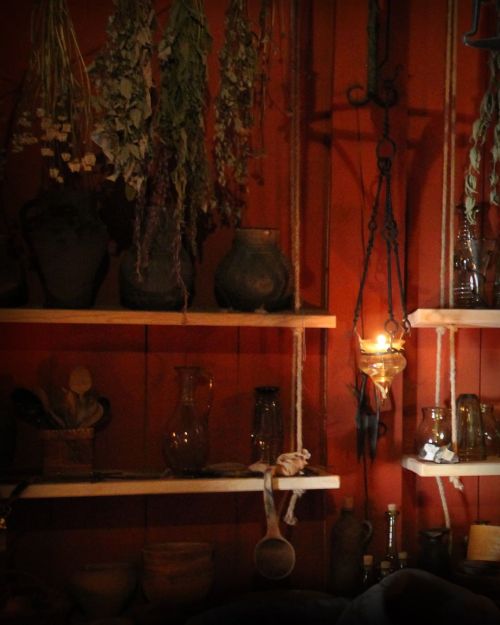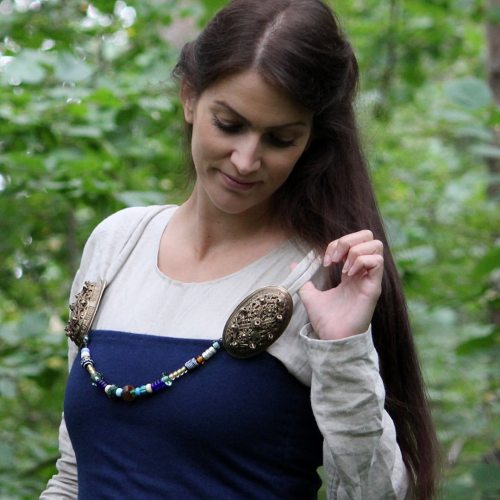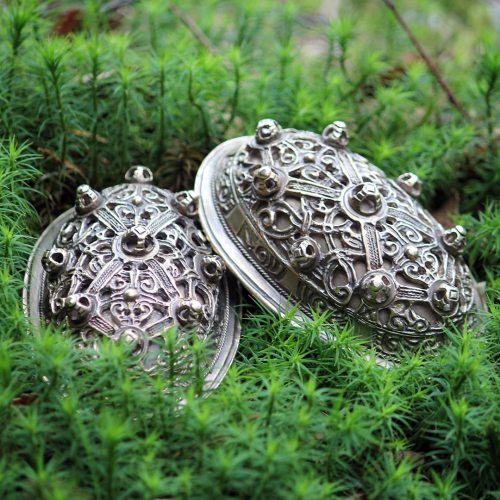#levendehistorie
My highest wish for New Year’s is a quiet celebration at home with my new little family. ❤️
I have spent the last few days in hospital due to a nasty infection, and while I love and admire the Norwegian health care system I must say I’m officially tired of spending time surrounded by naked concrete walls, beeping sounds and nightly disturbances by others than my newborn baby. My expectations that the “fourth trimester” was supposed to be tough led me to walk around with an untreated infection for weeks rather than seeking treatment, and I learned the hard way that gritting your teeth is not necessarily the best way to cope in all cases… I am recovering well now and it looks like I may be discharged tomorrow, so I’m keeping my fingers crossed to be home on this side of the new year!
How will you celebrate this New Year’s Eve? ✨
#newyear #newyears #gudvangen #njardarheimr #vikinghouse #vikingvillage #viking #vikings #norse #vikingage #vikingtid #reenactment #vikingreenactment #livinghistory #levendehistorie #archaeology #vikingsofinstagram #vikinglife #vikingblog #valkyrie #valkyrja
https://www.instagram.com/p/CYH93e5ty4u/?utm_medium=tumblr
Post link
Bú er betra,
þótt lítit sé,
halr er heima hverr.
~
One’s own house is best,
though small it may be,
each man is master at home.
(Hávamál - the Words of the High One)
#gudvangen #njardarheimr #håvamål #hávamál #viking #vikings #vikinghouse #norse #vikingage #vikingtid #reenactment #vikingreenactment #livinghistory #levendehistorie #archaeology #vikingsofinstagram #vikinglife #vikingblog #valkyrie #valkyrja
https://www.instagram.com/p/CVqOJlWNGG8/?utm_medium=tumblr
Post link
• The drop spindle •
Part 6/6 of “The woman at Spurkeland”, early 900s CE
Among the other identifiable objects in the grave were a loom weight and a spindle whorl both made of soapstone. These may refer to the Spurkeland woman’s role as a weaver in the household.
The production of fine clothes was associated with high status during the Viking Age, and could be a good source of income. The housewife would be responsible for the textile production, either as a weaver herself or a leader of weavers in the household.
The spindle whorl was unornamented and round with flat parallel sides. Neil from @NiddyNoddyUK was kind to make me this one to order, as well as a spindle stick and distaff to go with it (the latter were not found in this grave but are in Oseberg style).
Now I just have to learn how to spin properly!
#viking #vikings #norse #vikingage #vikingtid #reenactment #vikingreenactment #vikingreenactor #livinghistory #levendehistorie #archaeology #spurkeland #dropspindle #distaff #vikingsofinstagram #vikingsummer #vikinglife #vikingwoman #historicalclothing #vikingblog #valkyrie #valkyrja
https://www.instagram.com/p/CTU7AIZDMc5/?utm_medium=tumblr
Post link
• The shawl and trefoil fibula •
Part 5/6 of “The woman at Spurkeland”, early 900s CE
The third garment identified in the grave was an outer layer—believed to have been a shawl or cloak closed with a bronze trefoil brooch at the neck.
The brooch was decorated with three masks facing out toward each lobe with stylized bodies (Borre-style, type P97). I’ve used my trefoil brooch from @klesarven here, not the same design but also a Norwegian finding decorated with masks.
Five textile fragments were found in relation to the brooch. The weave was unclear, but they were wool, and there was blue dye!
The shape of the shawl/cloak is unknown, so I went for a simple “triangular” style shawl in thick wool, with blanket stitch along the edges to prevent fraying. The shawl is really a square piece where one corner is folded down and worn toward the back of the neck. This provides a nice shape when draped over the shoulders and fastened at the front, a shape that mimics the profile commonly seen in Valkyrie pendants. ✨
#viking #vikings #norse #vikingage #vikingtid #reenactment #vikingreenactment #vikingreenactor #livinghistory #levendehistorie #archaeology #spurkeland #vikingsofinstagram #vikingsummer #vikinglife #vikingwoman #vikingdress #handsewn #historicalclothing #vikingblog #valkyrie #valkyrja
https://www.instagram.com/p/CTP_ONfLi-8/?utm_medium=tumblr
Post link
Details…
One of the two blue/brown six-strand braids running down along the back of the apron dress (based on the Hedeby/Haithabu find), and the linen shoulder straps made by folding fabric fourfold and closing it with whip stitch.
#viking #vikings #norse #vikingage #vikingtid #reenactment #vikingreenactment #vikingreenactor #livinghistory #levendehistorie #archaeology #spurkeland #vikingsofinstagram #vikingsummer #vikinglife #vikingwoman #vikingbling #vikingdress #handsewn #historicalclothing #aprondress #vikingblog #valkyrie #valkyrja
https://www.instagram.com/p/CTKTObRDbgZ/?utm_medium=tumblr
Post link
The shoulder straps/loops on apron dresses seem to have usually been made of linen, also when the remainder of the dress is made of wool.
This is for example seen in the rich Birka material where vast majority of findings of such loops were linen, even though plant fibres usually decompose rapidly under Scandinavian preservation conditions.
This may be surprising to some, since we more often see wool loops on apron dresses among historical reenactors (including myself)!
Why do you think that is? Do you find it prettier when the shoulder straps and dress are identical in color and material?
That has been the case for my part. But after having made and worn these, I can definitely get used to this! Linen straps are also more durable and less stretchy, so they do their job well holding the heavy brooches in place.
#viking #vikings #norse #vikingage #vikingtid #reenactment #vikingreenactment #vikingreenactor #livinghistory #levendehistorie #archaeology #spurkeland #vikingsofinstagram #vikingsummer #vikinglife #vikingwoman #vikingbling #vikingdress #handsewn #historicalclothing #aprondress #vikingblog #valkyrie #valkyrja
https://www.instagram.com/p/CTKGBQOj_Zg/?utm_medium=tumblr
Post link
• The blue aprondress •
Part 4/6 of “The woman at Spurkeland”, early 900s CE
The second garment in the grave was identified as an apron dress.
Underneath the tortoise brooches, there were pieces of both the upper and lower looped straps used to suspend the dress over the shoulders. These were made of plant fibre, specifically linen.
Apart from these straps, the findings do not reveal more details about the design of the apron dress. I therefore based my interpretation on the largest and best-preserved existing find, namely the Hedeby/Haithabu fragment, with a closed and fitted design flaring from the hips and six-strand braids running down along the back.
I used blue wool fabric in a plain tabby weave, handsewn with wool thread. This seemed like the most plausible alternative based on previous findings as well as those wool fragments that were indeed found in the grave (more about that in part 5/6)!
#viking #vikings #norse #vikingage #vikingtid #reenactment #vikingreenactment #vikingreenactor #livinghistory #levendehistorie #archaeology #spurkeland #vikingsofinstagram #vikingsummer #vikinglife #vikingwoman #vikingbling #vikingdress #handsewn #historicalclothing #aprondress #vikingblog #valkyrie #valkyrja
https://www.instagram.com/p/CTIfHmgrF6M/?utm_medium=tumblr
Post link
• Linen underdress •
Part 3/6 of “The woman at Spurkeland”, early 900s CE
Findings of textile remains from the Viking Age are rare. Those that do survive have often been in direct contact with metal objects (protected by metal corrosion). Their location relative to various metal objects such as brooches, buttons or tools may provide clues about the type of garment, and analyses of thread-count and any dyes can indicate its quality and value.
Interpreting textile findings therefore requires a lot of just that: interpretation. That was also the case for this grave finding. According to textile conservator Lukešová, the small fragments found in the grave likely stem from three different garments.
The first was a linen undergarment, based on fragments of linen found under the tortoise brooches that do not stem from the apron dress. My reconstruction is a handsewn serk in undyed plain weave linen, and has a rounded neckline. While I usually sew serks with keyhole necklines, these were uncommon in findings here from West Norway. This is also supported by the fact that was apparently no brooch or fibula attached to this undergarment.
The findings provide little or no clue about the shape of the remainder of the serk, but I made square underarm gussets for better fit and movement (based on e.g. Skjoldehamn and Birka finds), long sleeves, a single panel for both front and back (no shoulder seam) and two side gores. This is basically a simple and straightforward serk design, made to form a practical and comfortable undergarment without more guesswork than necessary!
#viking #vikings #norse #vikingage #vikingtid #reenactment #vikingreenactment #vikingreenactor #livinghistory #levendehistorie #archaeology #spurkeland #vikingsofinstagram #vikingsummer #vikinglife #vikingwoman #vikingdress #handsewn #historicalclothing #vikingblog #valkyrie #valkyrja
https://www.instagram.com/p/CTC3LYDt9qv/?utm_medium=tumblr
Post link
• The beads •
Part 2/6 of “The woman at Spurkeland”, early 900s CE
Two dozen beads were found in the area around the brooches. One was a large discoid shaped amber bead measuring 22.6mm, and the remaining 23 were made of glass.
Originally, these beads had production sites spread across large geographical distances. For example, the segmented beads in blue and golden are believed to come from the Byzantine territory in the southeast, while the simple opaque ones may have been Scandinavian.
I did not have the beads made to order for this project, but simply tried to collect similar ones from brilliant vendors of handmade beads such as the ones tagged above. But recreating the bead row was challenging since all markets in my area were cancelled this summer, and especially because this grave find has not been recreated previously. The patterns and proportions of the individual beads are not accurate in all cases either. I aim to keep improving this as society and historical markets open up again!
Thanks to Søren Diinhoff at the University Museum of Bergen for access to the relevant reports as well as permission to use the second photo above, showing some of the original beads in situ.
#viking #vikings #norse #vikingage #vikingtid #reenactment #vikingreenactment #livinghistory #levendehistorie #archaeology #spurkeland #vikinglife #vikingbling #beads #historicalbeads #historicaljewelry #historicaljewellery #glassbeads #vikingblog #valkyrie #valkyrja
https://www.instagram.com/p/CTAzvDPL2FN/?utm_medium=tumblr
Post link
• The brooches •
Part 1/6 of “The woman at Spurkeland”, early 900s CE ✨
The bronze tortoise brooches found in the grave were double shelled. The open-work top shells were gold-plated and richly ornamented, with a smooth inner shell beneath. They are within type R652/654 (Rygh), categorized as P51 in Petersen’s classification of tortoise brooches.
This is actually the most common brooch design from the Viking Age, with findings spread from Norway (with about 50 findings in my county alone) to Denmark, Sweden, Iceland, the British Isles, Russia…
That makes you think, doesn’t it? I find it so interesting how these fashion designs managed to find their way to local farmsteads up hill and down dale, in a time where travel was done by foot, horse and ship.
#viking #vikings #norse #vikingage #vikingtid #reenactment #vikingreenactment #livinghistory #levendehistorie #archaeology #spurkeland #vikinglife #vikingbling #tortoisebrooches #historicalclothing #historicaljewelry #historicaljewellery #vikingblog #valkyrie #valkyrja
https://www.instagram.com/p/CS-CpG7Lmsa/?utm_medium=tumblr
Post link
The woman at Spurkeland, early 900s CE
Some years ago, a friend of mine found a tortoise brooch on a farm here on the west coast of Norway, which led to archaeological excavations that revealed a woman’s grave from the early 900s. The finding remained unpublished and has not been recreated until now. I was up for the challenge. How often do you come across such a relevant finding so close to home?
I’ve been working on this project for the past months, and will be sharing it with you here in the days to come! You will find the whole story and all photos on my blog Valkyrja.com (link in profile) ✨
#viking #vikings #norse #vikingage #vikingtid #reenactment #vikingreenactment #vikingreenactor #livinghistory #levendehistorie #archaeology #spurkeland #vikingsofinstagram #vikingsummer #vikinglife #vikingwoman #vikingbling #vikingdress #handsewn #historicalclothing #aprondress #vikingblog #valkyrie #valkyrja
https://www.instagram.com/p/CS47YwPLh28/?utm_medium=tumblr
Post link











